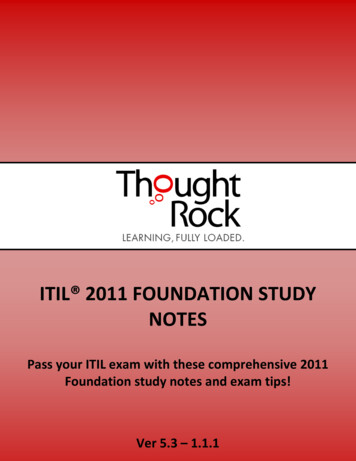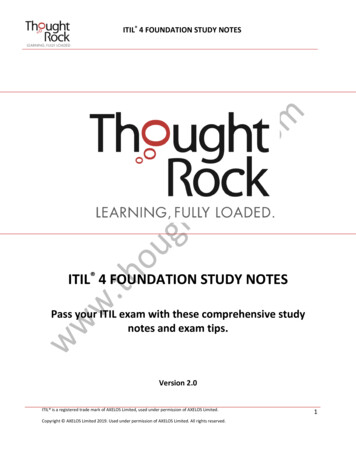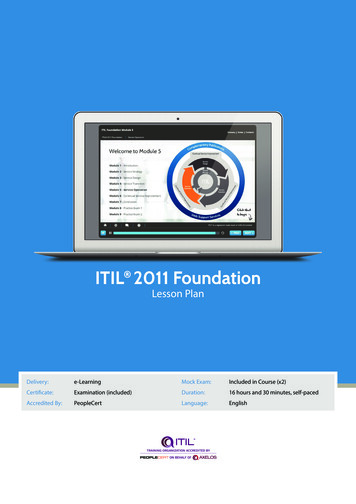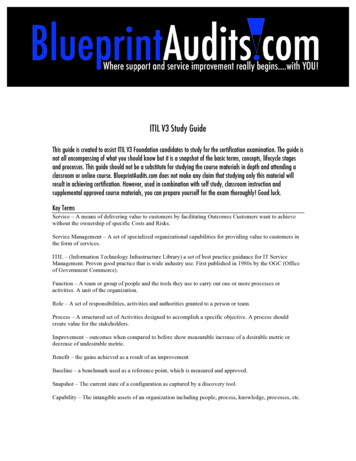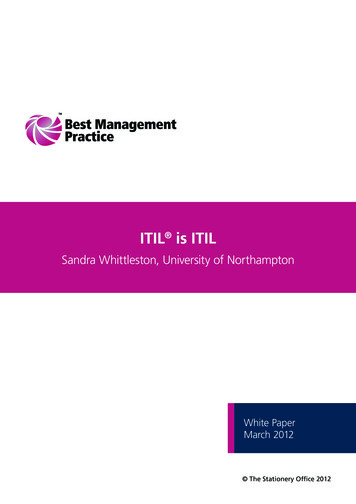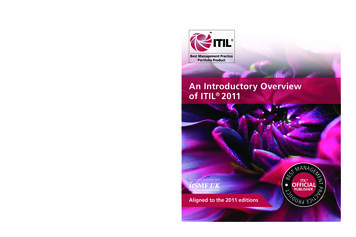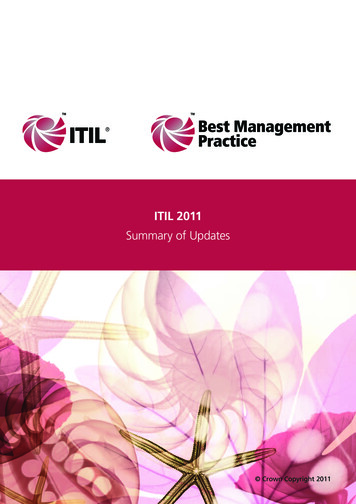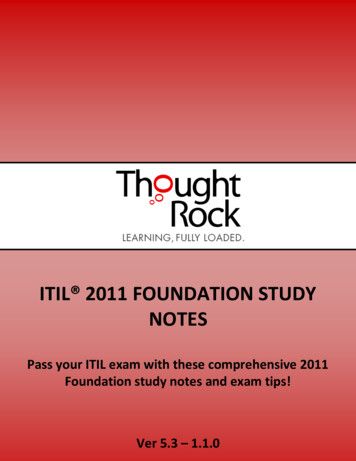
Transcription
ITIL 2011 FOUNDATION STUDYNOTESPass your ITIL exam with these comprehensive 2011Foundation study notes and exam tips!Ver 5.3 – 1.1.0
THIS IS A SAMPLE VERSION OF OUR STUDY NOTESFULL VERSION AVAILABLE AS PART OF THE ITIL BUNDLEBUY NOWContentsRead Me . 3Quick Exam Tips . 4Core Lifecycle Stages Flow . 5Module 1: Introducing ITIL 2011 . 6Outline. 6Learning Objectives . 6General Terms and Definitions Matrix. 7Module 2: Overview Core Lifecycle Stages . 11Outline Core Lifecycle Stages . 11Learning Objectives . 12Service Strategy . 12Service Design . 14Service Transition . 15Service Operation . 17Continual Service Improvement. 18Continual Service Improvement Outline . 18Exam Recap Summary . 20Module 3: Service Lifecycle Processes . 22Service Strategy . 22Service Strategy Outline . 22ITIL is a registered trade mark of AXELOS Limited, used under permission of AXELOS Limited. All rights reserved.Page 2
THIS IS A SAMPLE VERSION OF OUR STUDY NOTESFULL VERSION AVAILABLE AS PART OF THE ITIL BUNDLEBUY NOWRead MeHi There,If you’re reading this you’ve stumbled upon the best study notes you’ll find for ITIL 2011. Our students havehad great success with our online course using these notes. Still not convinced that these notes areawesome?!Here’s how to use the notes:Order in which you should review the study materials:(Find items a-e bolded included in Sample Notes)a. Exam Tipsb. Overview (a mapping of the Processes/Sub‐processes/Functions)c. Module 1d. Module 2e. Module 3 – SS (Service Strategy)f. Module 4 – SD (Service Design)g. Module 5 – ST (Service Transition)h. Module 6 – SO (Service Operation)i.Module 7 – CSI (Continual Service Improvement)j.Overview (a mapping of the Processes/Sub‐processes/Functions)1. The first page of every note contains a list of constructs (processes / functions / etc.) that may be testedon. If you can go through the first page of every document and answer/define/understand the constructswithout looking at the answers, you’re ready to move onto the next document.2. While these notes are close to a complete study guide, keep in mind that getting answers wrong on thepractice tests is an invaluable exercise which will help you determine the constructs you still need todecipher. For example, I thought I knew what a “workaround” was, but I had to get it wrong on thepractice exam to recognize I needed to understand/memorize ITIL’s definition.Best of luck! And hey, if you need help, don’t hesitate to contact us (info@thoughtrock.net) regardless ofwhether you’re taking the course through us. We’ll help!Your study partner, Thought RockVisit www.thoughtrock.net/theitilexam for more details.ITIL is a registered trade mark of AXELOS Limited, used under permission of AXELOS Limited. All rights reserved.Page 3
THIS IS A SAMPLE VERSION OF OUR STUDY NOTESFULL VERSION AVAILABLE AS PART OF THE ITIL BUNDLEBUY NOWITIL 2011 Foundation ‐ Study NotesQuick Exam TipsPrepping for the ITIL 2011 Foundation Exam? Here are some key points to keep in mind:1. Memorize your definitions. The questions on the exam will provide 2 out of 4 answers that make senseand are very similar when referring to a term, and so if you don’t have the term memorized, you’ll bestuck. Trust us; 15 questions on the exam will be just like this.2. Understanding the interrelationships, jurisdictions, and subtle differences between the terms, processes,sub‐processes & functions is just as important as understanding the constructs themselves. For example: What is the difference between Availability & Capacity Management? How does Operational Control differ from Technical Management? What is the difference between a workaround and a resolution in the context of IncidentManagement? What’s in the Service Catalogue compared to the Service Pipeline compared to the Service Portfolio? What’s a Rollout compared to a Deployment? Any of the roles! What does an Asset Manager do compared to a Configuration Manager? ServiceOwner vs. Process Owner? Event vs. Alert vs. Incident?3. When memorizing definitions, you can get stuck in the weeds. Knowing the overall structure of ITIL 2011will help you organize the information in your mind and help resolve jurisdiction questions (i.e. who doeswhat?). So create an outline like this (we’ve started it off for you):Service Strategy1.1. Service Portfolio3.1. Financial ManagementService Design1.1. Change Management2.1. Etc.ITIL is a registered trade mark of AXELOS Limited, used under permission of AXELOS Limited. All rights reserved.Page 4
THIS IS A SAMPLE VERSION OF OUR STUDY NOTESFULL VERSION AVAILABLE AS PART OF THE ITIL BUNDLEBUY NOWCore Lifecycle Stages FlowITIL 2011 Foundation Overview1. ServiceStrategy1.1 Service Portfolio Management1.2 Business Relationship Management1.3 Financial Management for IT Services2. ServiceDesign2.0 Design Coordination2.1 Service Catalogue Management2.2 Service Level Management2.3 Availability Management2.4 Capacity Management2.5 IT Service Continuity Management2.6 Supplier Management3. ServiceTransition3.0 Transition Planning and Support3.1 Change Management3.2 Release & Deployment Management3.3 Service Asset & ConfigurationManagement3.4 Knowledge Management4.1FunctionsvvvvService DeskTechnical ManagementApplication ManagementIT Operations Management4.2ProcessesvvvvvEvent ManagementIncident ManagementRequest FulfillmentAccess ManagementProblem Management4. ServiceOperation5. ContinuousServiceImprovement5.1 Seven-Step Improvement ProcessITIL is a registered trade mark of AXELOS Limited, used under permission of AXELOS Limited. All rights reserved.Page 5
FULL VERSION AVAILABLE AS PART OF THE ITIL BUNDLEBUY NOWModule 1: Introducing ITIL 2011Outline1. Module 1 ‐ Introducing ITIL1.1 ITSM –Defined Provides (3) Doesn’t Include Objectives1.2 ITIL1.3 Best Practice1.4 ITIL Core Lifecycle1.5 Functions vs. Processes1.6 Authority Matrix How it helps RACI model1.7 Customers and Stakeholders1.8 Process Owner vs. Service Owner1.9 Process manager vs. Process Practitioner1.10 Technology Tools1.11 ServicesLearning ObjectivesThis course is divided into modules. Each module has objectives, activities, and a quiz. This first moduleprovides an overview of ITIL and ITSM. Take a minute to read the objectives for this module.By the end of this module, you will be able to:Explain how 'Foundations of IT Service Management' is based on ITIL.Define functions, processes, and roles within ITSM.Identify the four main roles of the Authority Matrix using the RACIModel.ObjectivesIdentify the primary activities of processes.Explain three benefits of ITIL.Distinuish between the five ITIL lifecycle stages.ITIL is a registered trade mark of AXELOS Limited, used under permission of AXELOS Limited. All rights reserved.Page 6
FULL VERSION AVAILABLE AS PART OF THE ITIL BUNDLEBUY NOWGeneral Terms and Definitions MatrixTermITSMDefinition/PointA process-centered approach to delivery IT services that meetsbusiness needs according to performance targets. Set of organizational capabilities/resources to add value toservices/goodsCapabilities are skills and require raw materials; resources arethe raw materials Provides:ITIL Best practices for ITSMCommon languageDrives continual improvementDoesn’t include methodology to implementObjective: Contribute value to the organization by alignment of IT &businessIncrease efficiency (cost/time)Improve effectiveness (meet quality requirements) Successful Because: Vendor NeutralNon-PrescriptiveBest Practice in ITSMFocus:ITIL LifecycleBest Practice Best superior outcomes to normal practices in wide industryuse. Sources include: How ITIL can help add valueUnderstanding IT service needsImproving quality service provisioningProviding cost justifiable service qualityIdentifying roles/responsibilitiesUsing KB approachIdentifying KPI’s Public frameworksStandardsProprietary knowledge of organizations and individualsDocumenting, negotiating, & solidifying customer/businesstargetsITIL is a registered trade mark of AXELOS Limited, used under permission of AXELOS Limited. All rights reserved.Page 7
FULL VERSION AVAILABLE AS PART OF THE ITIL BUNDLEBUY NOWTermDefinition/Point Regularly assess customer’s perceptions via feedback Ensure IT personnel adapt to business5 stagesITIL Core LifecycleI. Service Strategy – strategic approach to ITSMII. Service Design –holistic approach to thoroughly designingservices with the 4Ps and 5 Design AspectsIII. Service Transition – develops/improves capabilities fornew/changing IT services into ops; focuses on moving fromobjective to how to achieve itIV. Service Operation – deliver/support IT services per SLAs;effective/efficiency keyV. CSI - provide structure stability strength to service mgmtcapabilities with principles methods & tools Function, Roles, Processes Function – units carrying out things; contain on BOK; providestructureRoles – staff involved in process/service delivery; key roles areProcess Owner vs. Service OwnerProcesses – Set of coordinated activities combiningcapabilities & resources to produce value‐add outcome tostakeholderIntegrated processes through which organizations can meetgoals with efficiency and effectiveness.Primary characteristics of processes:ITIL Processes MeasurableSpecific resultsStakeholdersSpecific eventsInputs activities outputClarifies activities to do:Authority Matrix Responsibility – execution of process/activitiesAccountable – ownership of quality/end resultConsulted – involvement through input of knowledgeInformed – receiving info. about process execution/qualityOnly 1 person is accountable for an activity; multiple may beresponsible.Accountability must remain with 1 person for all activities in aprocess.ITIL is a registered trade mark of AXELOS Limited, used under permission of AXELOS Limited. All rights reserved.Page 8
FULL VERSION AVAILABLE AS PART OF THE ITIL BUNDLEBUY NOWTermDefinition/Point Customers and stakeholders Internal Customers work at same business as Service ProviderExternal Customers work at different business from ServiceProviderInternal Stakeholders are internal to the Service ProviderExternal Stakeholders are external to the Service Provider,such as Users, Customers, and SuppliersProcess Owner role:Process vs. Service Owner Defining processesAssisting in process designReview process strategyService Owner - Initiation, transition, ongoing maintenance/support of service (fulfillment); ensures customers aresatisfied.Service Owner role:Process Manager/PractitionerTechnology tools Single point of contact (SPOC)Ensuring delivery meets requirementsIdentifies opportunities for improvementWorks with other owners Process Manager accountable for the operationalmanagement of a processProcess Practitioner responsible for carrying out one or moreprocess activities WorkflowKBTestingBIDiscoveryActions required before selecting toolsService Means of giving value by allowing outcomes sans ownershipEnable – provides employee with computer; enables to workBy enabling them to work, software and network access areembeddedInternal Services are delivered within the same organizationExternal
RACI model 1.7 Customers and Stakeholders 1.8 Process Owner vs. Service Owner 1.9 Process manager vs. Process Practitioner 1.10 Technology Tools 1.11 Services Learning Objectives This course is divided into modules. Each module has objectives, activities, and a quiz. This first module provides an overview of ITIL and ITSM. Take a minute to read the objectives for this module.
